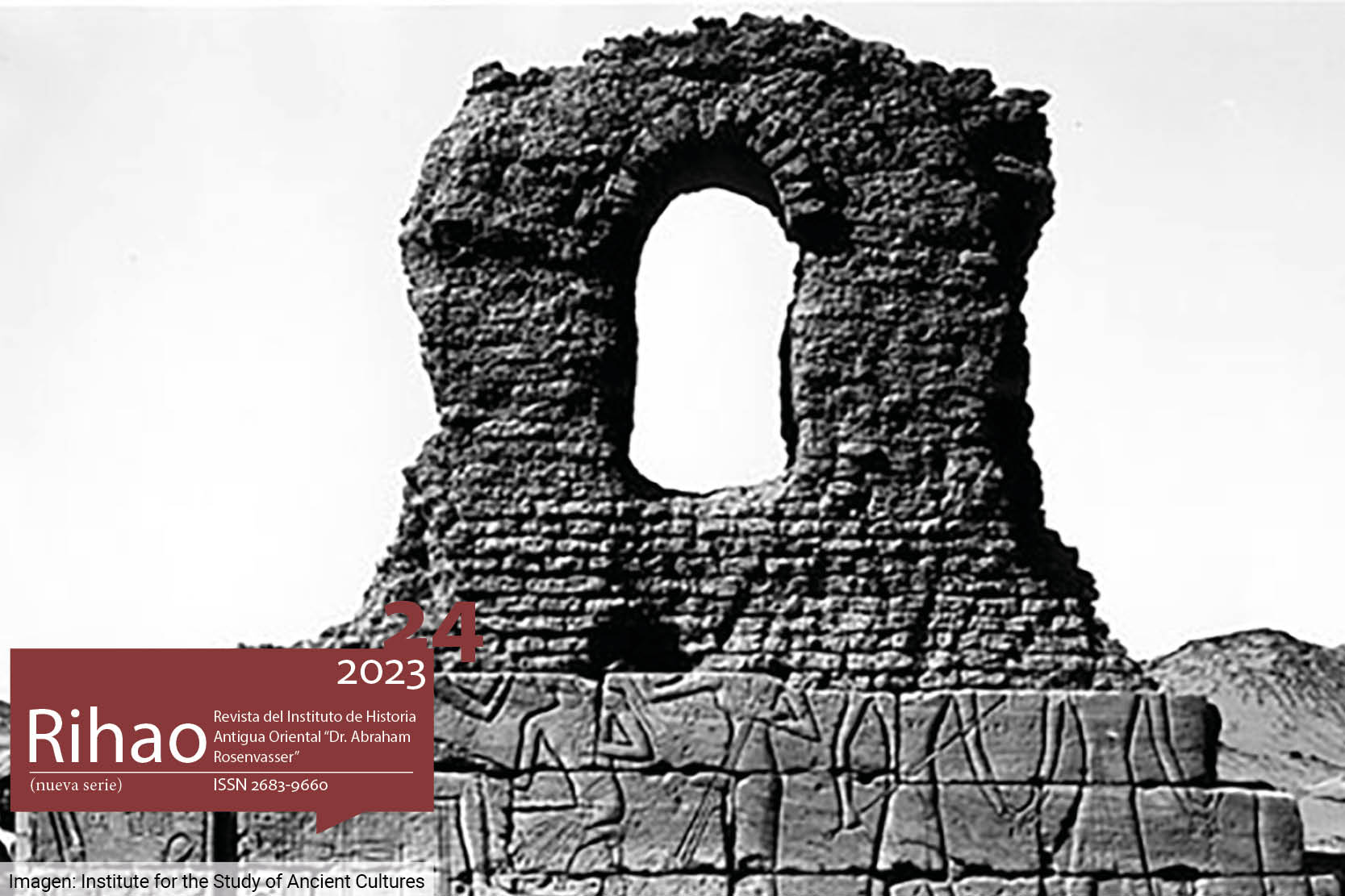Offerings for the Afterlife. A Proposal for the Analysis of the Doorway to the Chapel of the Tomb of Amenmose (TT 318)
Keywords:
Egypt, Theban Tombs, Amenmose, offering formulas
Abstract
This paper aims to provide an analysis of the doorway to the inner chapel or room in the Theban Tomb 318 (TT 318). This tomb, located in Sheikh Abd el-Qurna, belonged to a stonemason/worker of the necropolis of Amun called Amenmose who lived during the reigns of Hatshepsut and Thutmose III, in the Eighteenth Dynasty. A passage or doorway consisting of a lintel and two jambs connected the transverse hall to the inner chapel. It contained offering formulas for the ka of the deceased and depicted Amenmose and his wife worshiping Anubis and the goddesses of the East and the West. The study of the lintel and its jambs as well as their texts enable us to define this passage as a liminal space where the texts on its jambs can be understood in line with a reading model based on a pattern of internal circulation inside the monument.Downloads
Download data is not yet available.
References
Allen, J. (2011). The debate between a man and his soul: a masterpiece of ancient Egyptian literature (Culture and History of the Ancient Near East 44). Leiden: Brill.
Antoniadou, C. (2018). Anubis: The God’s Manifestation in the Iconographical and Literary Sources of the Pharaonic Period. Postgraduate Dissertation. Rodas: University of the Aegean.
Arnold, D. (2003). The Encyclopaedia of Ancient Egyptian Architecture. Translated by Sabine H. Gardiner and Helen Strudwick. Londres: I. B. Tauris.
Barta, W. (1968). Aufbau und Bedeutung der altägyptischen Opferformel. Glückstadt: J. J. Augustin.
Bryan, B. (2009). Memory and Knowledge in Egyptian Tomb Painting, en: Cropper, E. (ed.), Dialogues in Art History, from Mesopotamian to Modern: Readings for a New Century. Washington: National Gallery of Art, 19-39.
Dodson, A. e Ikram, S. (2008). The Tomb in Ancient Egypt: Royal and Private Sepulchres from the Early Dynastic Period to the Romans. Londres: Thames & Hudson.
Engelbach, R. (1924). A Supplement to the Topographical Catalogue of the Private Tombs of Thebes (Nos. 253 to 334) with Some Notes on the Necropolis From 1913 to 1924. El Cairo: Printing Office of the French Institute of Oriental Archaeology.
Hartwig, M. (2004). Tomb painting and identity in ancient Thebes, 1419-1372 BCE. Bruselas / Turnhout: Fondation Égyptologique Reine Élisabeth / Brepols.
Ikram, S. (2009). Ancient Egypt: An Introduction. Cambridge: Cambridge University Press.
Kampp, F. (1996). Die thebanische Nekropole: zum Wandel des Grabgedankens von der 18. bis zur 20. Dynastie (Theben 13). Maguncia: Zabern.
Kampp-Seyfried, F. (2003). The Theban necropolis: an overview of topography and tomb development from the Middle Kingdom to the Ramesside period, en: Strudwick, N. y Taylor, J. H. (eds.), The Theban necropolis: past, present and future. Londres: British Museum Press, 2-10.
LÄ = Helck, W. y Otto, E. (eds. vol. I); Helck, W. y Westendorf, W. (eds. vols. II-VII). (1975-1992). Lexikon der Ägyptologie, 7 vols. Wiesbaden: Harrassowitz.
Leitz, C. (ed.) (2002). Lexikon der ägyptischen Götter und Götterbezeichnungen, 8 vols. (Orientalia Lovaniensia Analecta 110-116, 129). Lovaina: Peeters.
Manniche, L. (1987). City of the dead: Thebes in Egypt. Londres: British Museum Publications.
Manzi, L., Yomaha, S. y Zingarelli, A. (2022). Informe de la primera campaña en la tumba de Amenmose (TT318), Luxor-Egipto, en: Revista del Museo de Antropología 15 (3): 33-48.
McQuinn, Z. (2011). Immortal visages in the Diniacopoulos Collection: a statue group from Theban Tomb 318, en: Francis, J. E. y Harrison, G. W. M. (eds.), Life and death in ancient Egypt: the Diniacopoulos Collection. Montreal: Concordia University, 68-72.
Meyer-Dietrich, E. (2010). Recitation, Speech Acts, and Declamation, en: Wendrich, W. (ed.), UCLA Encyclopedia of Egyptology. Los Ángeles: UCLA. En línea: http://escholarship.org/uc/item/1gh1q0md. [Consultado: 30-11-2021].
Pamminger, P. (1991). Das Trinken von Überschwemmungswasser: eine Form der jährlichen Regeneration des Verstorbenen, en: Göttinger Miszellen 122: 71-75.
Porter, B. y Moss, R. (1960). Topographical bibliography of ancient Egyptian hieroglyphic texts, reliefs, and paintings. Vol. 1: The Theban Necropolis. Part 1: Private Tombs. Oxford: Griffith Institute.
Refai, H. (1996). Die Göttin des Westens in den thebanischen Gräbern des Neuen Reiches: Darstellung, Bedeutung und Funktion (Abhandlungen des Deutschen Archäologischen Instituts Kairo, Ägyptologische Reihe 12). Berlín: Achet.
Robins, G. (2010). Space and movement in pre-Amarna Eighteenth Dynasty Theban tomb chapels, en: Woods, A., McFarlane, A. y Binder, S. (eds.), Egyptian culture and society: studies in honour of Naguib Kanawati, vol. 2. El Cairo: Conseil Suprême des Antiquités, 129-142.
Roeten, L. (2021). Doors, entrances and beyond…: various aspects of entrances and doors of the tombs in the Memphite necropoleis during the Old Kingdom (Archaeopress Egyptology 33). Oxford: Archaeopress.
Taylor, J. (2001). Death and the Afterlife in Ancient Egypt. Londres: British Museum Press.
Antoniadou, C. (2018). Anubis: The God’s Manifestation in the Iconographical and Literary Sources of the Pharaonic Period. Postgraduate Dissertation. Rodas: University of the Aegean.
Arnold, D. (2003). The Encyclopaedia of Ancient Egyptian Architecture. Translated by Sabine H. Gardiner and Helen Strudwick. Londres: I. B. Tauris.
Barta, W. (1968). Aufbau und Bedeutung der altägyptischen Opferformel. Glückstadt: J. J. Augustin.
Bryan, B. (2009). Memory and Knowledge in Egyptian Tomb Painting, en: Cropper, E. (ed.), Dialogues in Art History, from Mesopotamian to Modern: Readings for a New Century. Washington: National Gallery of Art, 19-39.
Dodson, A. e Ikram, S. (2008). The Tomb in Ancient Egypt: Royal and Private Sepulchres from the Early Dynastic Period to the Romans. Londres: Thames & Hudson.
Engelbach, R. (1924). A Supplement to the Topographical Catalogue of the Private Tombs of Thebes (Nos. 253 to 334) with Some Notes on the Necropolis From 1913 to 1924. El Cairo: Printing Office of the French Institute of Oriental Archaeology.
Hartwig, M. (2004). Tomb painting and identity in ancient Thebes, 1419-1372 BCE. Bruselas / Turnhout: Fondation Égyptologique Reine Élisabeth / Brepols.
Ikram, S. (2009). Ancient Egypt: An Introduction. Cambridge: Cambridge University Press.
Kampp, F. (1996). Die thebanische Nekropole: zum Wandel des Grabgedankens von der 18. bis zur 20. Dynastie (Theben 13). Maguncia: Zabern.
Kampp-Seyfried, F. (2003). The Theban necropolis: an overview of topography and tomb development from the Middle Kingdom to the Ramesside period, en: Strudwick, N. y Taylor, J. H. (eds.), The Theban necropolis: past, present and future. Londres: British Museum Press, 2-10.
LÄ = Helck, W. y Otto, E. (eds. vol. I); Helck, W. y Westendorf, W. (eds. vols. II-VII). (1975-1992). Lexikon der Ägyptologie, 7 vols. Wiesbaden: Harrassowitz.
Leitz, C. (ed.) (2002). Lexikon der ägyptischen Götter und Götterbezeichnungen, 8 vols. (Orientalia Lovaniensia Analecta 110-116, 129). Lovaina: Peeters.
Manniche, L. (1987). City of the dead: Thebes in Egypt. Londres: British Museum Publications.
Manzi, L., Yomaha, S. y Zingarelli, A. (2022). Informe de la primera campaña en la tumba de Amenmose (TT318), Luxor-Egipto, en: Revista del Museo de Antropología 15 (3): 33-48.
McQuinn, Z. (2011). Immortal visages in the Diniacopoulos Collection: a statue group from Theban Tomb 318, en: Francis, J. E. y Harrison, G. W. M. (eds.), Life and death in ancient Egypt: the Diniacopoulos Collection. Montreal: Concordia University, 68-72.
Meyer-Dietrich, E. (2010). Recitation, Speech Acts, and Declamation, en: Wendrich, W. (ed.), UCLA Encyclopedia of Egyptology. Los Ángeles: UCLA. En línea: http://escholarship.org/uc/item/1gh1q0md. [Consultado: 30-11-2021].
Pamminger, P. (1991). Das Trinken von Überschwemmungswasser: eine Form der jährlichen Regeneration des Verstorbenen, en: Göttinger Miszellen 122: 71-75.
Porter, B. y Moss, R. (1960). Topographical bibliography of ancient Egyptian hieroglyphic texts, reliefs, and paintings. Vol. 1: The Theban Necropolis. Part 1: Private Tombs. Oxford: Griffith Institute.
Refai, H. (1996). Die Göttin des Westens in den thebanischen Gräbern des Neuen Reiches: Darstellung, Bedeutung und Funktion (Abhandlungen des Deutschen Archäologischen Instituts Kairo, Ägyptologische Reihe 12). Berlín: Achet.
Robins, G. (2010). Space and movement in pre-Amarna Eighteenth Dynasty Theban tomb chapels, en: Woods, A., McFarlane, A. y Binder, S. (eds.), Egyptian culture and society: studies in honour of Naguib Kanawati, vol. 2. El Cairo: Conseil Suprême des Antiquités, 129-142.
Roeten, L. (2021). Doors, entrances and beyond…: various aspects of entrances and doors of the tombs in the Memphite necropoleis during the Old Kingdom (Archaeopress Egyptology 33). Oxford: Archaeopress.
Taylor, J. (2001). Death and the Afterlife in Ancient Egypt. Londres: British Museum Press.
Published
2023-12-01
How to Cite
Rosell, P. M. (2023). Offerings for the Afterlife. A Proposal for the Analysis of the Doorway to the Chapel of the Tomb of Amenmose (TT 318). Revista Del Instituto De Historia Antigua Oriental ’Dr. Abraham Rosenvasser’, (24). https://doi.org/10.34096/rihao.n24.13748
Issue
Section
Dossier. Egiptología iberoamericana (primera parte)





.jpg)







